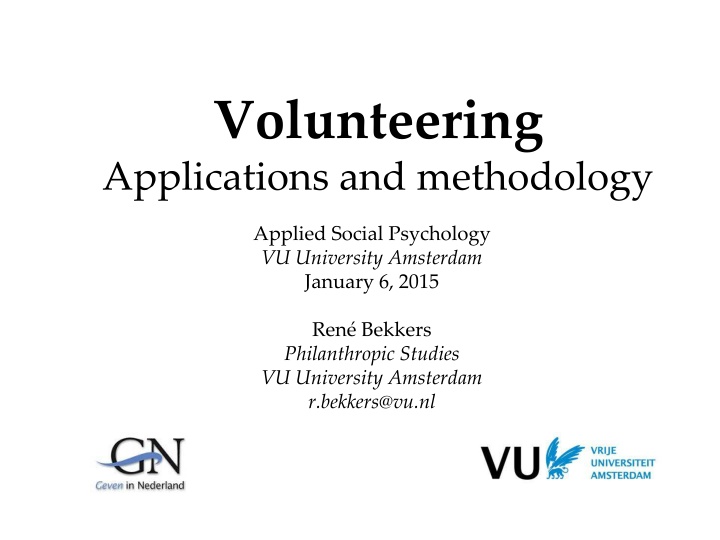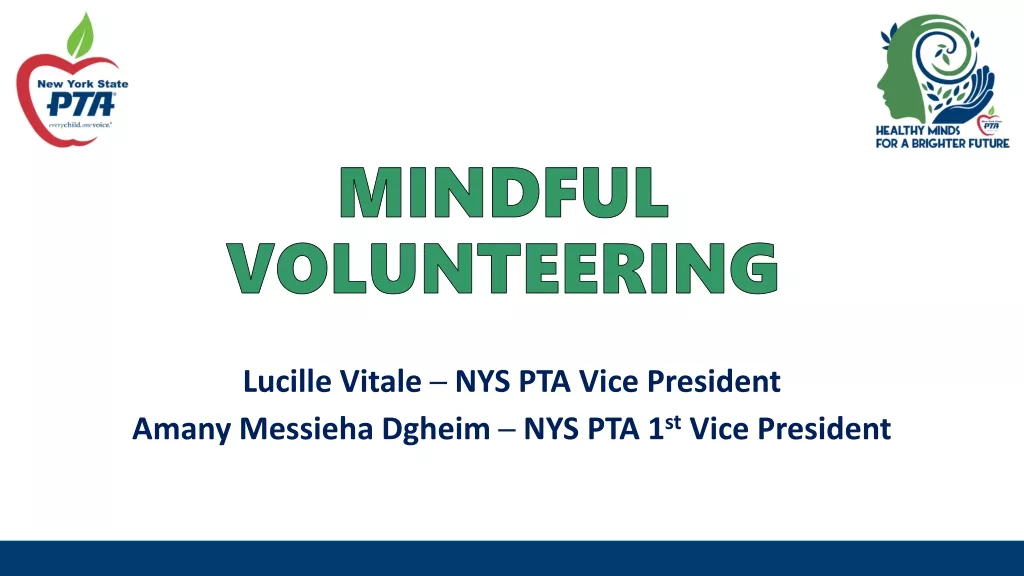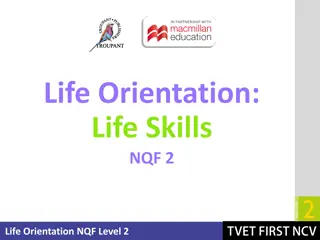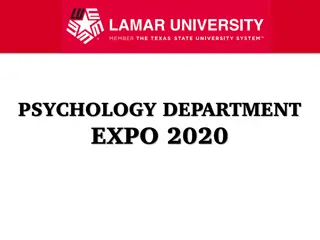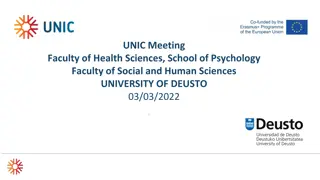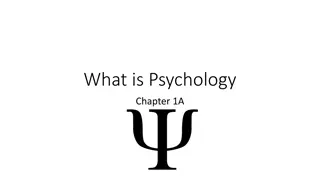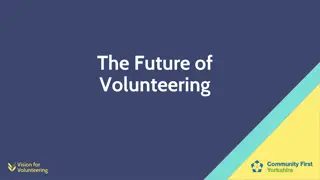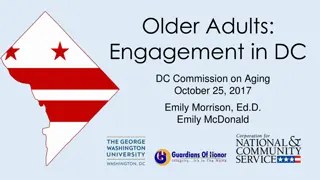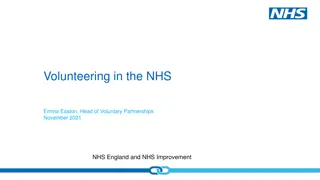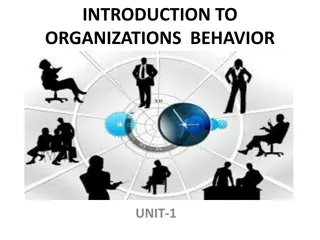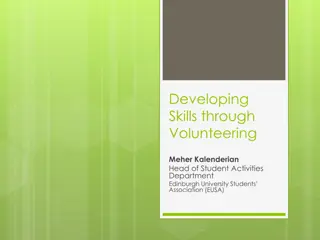Social Psychology in Volunteering: Theory, Data, and Methodology
Today's story delves into utilizing social psychology theories to promote giving and volunteering. Explore the impact of volunteering on trust, health, and societal participation. Uncover the importance of volunteerism in addressing social dilemmas and benefiting both individuals and communities.
Download Presentation

Please find below an Image/Link to download the presentation.
The content on the website is provided AS IS for your information and personal use only. It may not be sold, licensed, or shared on other websites without obtaining consent from the author.If you encounter any issues during the download, it is possible that the publisher has removed the file from their server.
You are allowed to download the files provided on this website for personal or commercial use, subject to the condition that they are used lawfully. All files are the property of their respective owners.
The content on the website is provided AS IS for your information and personal use only. It may not be sold, licensed, or shared on other websites without obtaining consent from the author.
E N D
Presentation Transcript
Volunteering Applications and methodology Applied Social Psychology VU University Amsterdam January 6, 2015 Ren Bekkers Philanthropic Studies VU University Amsterdam r.bekkers@vu.nl
Todays story How can we use insights from social psychology theories and research to get people to give and volunteer more? Today s story is not about tricks - nudging and priming . Instead, it is about theory, data, methodology, and the industry called social science .
The Empirical Cycle Context Policy RQ Research Theory
Context 1. Participation society : volunteers become more important in the provision of public goods. 2. Trust crisis : trust in banks, organized religion, politics, and ultimately generalized social trust are at risk. 3. In an ageing society, keeping people active as long as possible may reduce health costs.
Research Questions 1. Does volunteering make people more trusting? 2. Does volunteering keep people healthy? leaving the question How can we get people to volunteer more? for a future occasion.
Now heres a social dilemma Should I volunteer?
This is a social dilemma because There is an opportunity cost for me: volunteering takes time that I could spend working for pay. The benefits of volunteering accrue to a collective. Personally I would be better off not volunteering, but the group would not.
What type of social dilemma? Trust game Dictator game Ultimatum game Public goods game Volunteer s dilemma Samaritan s dilemma Or something else? Perhaps it is not a social dilemma at all.
Three facts 1. Volunteers live in better health. 2. Volunteers are less likely to get depressed. 3. Volunteers ultimately live longer.
More facts Volunteers have larger and more diverse social networks. Volunteers have more altruistic values, a stronger sense of social responsibility, and a stronger belief in the trustworthiness of others.
So If these are the results of voluntary participation, there is no social dilemma at all!
But Does volunteering indeed have these nice benefits for volunteers? Are networks, trust, health, subjective well being the result of volunteering?
Whence the difference? Do the attitudes, values, networks, and health change because people volunteer? This is the common interpretation. CAUSATION: Networks Values Health Voluntary action
Whence the difference? Or do attitudes, values, networks, and health lead people to volunteer? This is the SELECTION Model: Networks Values Health Voluntary Action
Or perhaps.. The relationship between volunteering, attitudes, values, networks, and health is confounded by OMITTED VARIABLES: Voluntary Action Other factors Networks Values Health x e.g., education, religion
Selection Selection: some people are more likely to be drawn into voluntary action. These are the more happy, trusting, healthy, people with larger networks. They are more likely to start volunteering, and they are less likely to quit volunteering.
A theory on selection for values Interactionism in personality and social psychology Individual differences in prosocial values shape the attractiveness of situations that involve contributions to the well being of others Individuals with larger networks are more likely to be asked to start and continue volunteering Individuals in better health are more able to continue volunteering
Theories on causation for values Group socialization theory People adopt the values of the groups that they are in (family, church, work) Social capital (attitude) formation Self-perception theory People adapt their values and self-identity to their behavior Role identity theory: volunteer role identity is reinforced through volunteering
Other theories on causation Meeting opportunities People gain access to new networks in organizations through participation Social capital (network) formation Networks protect health Information, social control, access to social support, stress buffering effect Personality strength Mastery, self-efficacy, purpose in life
Data and methods of previous studies Many studies use cross-sectional data, including a limited set of controls. Selection and omitted variables are a huge problem here. Studies using longitudinal panel data have almost all used inadequate regression models. Selection and omitted variables are still a problem here.
Adequate Testing, Please! The conventional change model includes a lagged dependent variable Yt-1 Halaby (2004, Annual Review of Sociology) shows this is not enough. The Yt-1 does not rule out selection effects. Use fixed effects regression models, eliminating variance between individuals Previous studies have rarely used this.
Giving in the Netherlands Panel Study (GINPS) A sample of individuals fills out surveys on the web every other year since 2002 You are welcome to use these data. See the user manual at http://geveninnederland.nl/file/208/ginps_codebook.pdf
Development of generalized social trust ( most people can be trusted ) 3,5 3,4 3,3 never quit joined sustained 3,2 3,1 3 2,9 2002 2004 2006 Source: GINPS Bekkers, R. (2012). Trust and Volunteering: Selection or Causation? Evidence From a 4 Year Panel Study . Political Behaviour, 34: 225-247, DOI 10.1007/s11109-011-9165-x (open access)
Volunteering effects on values Trust Altruistic values Social responsibility Constant 3.125 3.460 3.727 Random effects ***.096 ***.203 ***.147 Fixed effects -.034 **.058 .035 Hausman test ***22.72 ***96.62 ***30.30 Estimates on effects of volunteering (m=40%) from random and fixed effects regression models. Source: GINPS, 2002- 2006 (n=4,754; 2,783). Bekkers, R. (2007). Values and Volunteering. A Longitudinal Study of Reciprocal Influences in the Giving in the Netherlands Panel Study . Paper presented at the 36th Arnova conference, Atlanta, 2007.
Similar results in other countries Switzerland (SHP) UK Australia (HILDA) (BHPS) Random effects ***.957 ***.182 ***.485 Fixed effects -.053 ***.033 .034 First difference .025 ***.049 .039 Estimates on effects of volunteering in Switzerland (m=32%), the UK (21%) and Australia (18%) from between and fixed effects logistic regression models of trust. Van Ingen, E. & Bekkers, R. (2013). Trust Through Civic Engagement? Evidence from Five National Panel Studies. Political Psychology. DOI: 10.1111/pops.12105
Effects of trust A one SD increase in trust is associated with a 2.3% increase in the likelihood of starting to volunteer, 3.5% decrease in quitting, and 8.3% increase in the likelihood of being asked to volunteer Bekkers, R. (2012). Trust and Volunteering: Selection or Causation? Evidence From a 4 Year Panel Study . Political Behaviour, 34: 225-247, DOI 10.1007/s11109-011-9165-x (open access)
Selection and omitted variables + Start t0-2 Altruistic values t0 - + + Quit t0-2 Trust t0 + Confidence t1+ Confidence t2 Based on Bekkers, R. & Bowman, W. (2009). The Relationship Between Confidence in Charitable Organizations and Volunteering Revisited. Nonprofit & Voluntary Sector Quarterly, 38 (5): 884-897.
Laurence (2015) How does job displacement affect trust? The NCDS was a sample of all individuals born in a single week in March, 1958. What happened to trust in the UK between 1991 and 2008? What happened to the trust of those Britons whose jobs were displaced between 1991 (age 33) and 2008 (age 50)?
Changes from age 33 to 50 0 500 1000 1500 2000 2500 3000 3500 N = to distrust (at 50) distrust (at 33) to 'depends' (at 50) to trust (at 50) FROM to distrust (at 50) trust (at 33) to 'depends' (at 50) to trust (at 50)
Changes from age 33 to 50 0 500 1000 1500 2000 2500 3000 3500 N = to distrust (at 50) distrust (at 33) to 'depends' (at 50) to trust (at 50) FROM LOSS OF TRUST to distrust (at 50) trust (at 33) to 'depends' (at 50) to trust (at 50)
Questions for Laurence (2015) The article uses longitudinal data, right? How are selection effects taken into account? How can you check for selection effects by inspecting changes in X as a result of changes in Y in this case? How is the lagged dependent model different from a fixed effects model?
Volunteering Effects on Health Depression (CESD) Subjective health Constant 8.809 3.540 Random effects ***-1.569 ***.163 Fixed effects ***-.814 ***.097 Hausman test ***36.96 ***19.00 Estimates on effects of volunteering on depression and subjective health from random and fixed effects models. Source: LASA, 1992-2002 (n=7,864; 2,362). Bekkers, R., Van Tilburg, T.G., Aartsen, M., Brown, S. & Wilson, J. (2007). Volunteering and Health: A Prospective Study of Mediating Mechanisms . Unpublished manuscript.
So Use longitudinal data and then still do not claim too much about effects of voluntary action. Selection effects are a big part of the reason why voluntary action is related to networks, values and health. Always check for selection effects by inspecting changes in X as a result of changes in Y . Estimate fixed effects and first difference models.
Questions on Konrath et al. The article uses longitudinal data, right? How are selection effects taken into account? How can you check for selection effects by inspecting changes in X as a result of changes in Y in this case? How to estimate a fixed effects model of mortality? How to estimate a first difference model?
Contact Geven in Nederland , Philanthropic Studies, Faculteit Sociale Wetenschappen, Vrije Universiteit Amsterdam: www.geveninnederland.nl Ren Bekkers, r.bekkers@vu.nl Blog: renebekkers.wordpress.com Twitter: @renebekkers Please do get in touch if you want to write your thesis on charitable giving, volunteering, blood donation, etc.!
